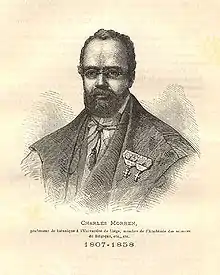Charles François Antoine Morren
Charles François Antoine Morren (3 March 1807 in Ghent – 17 December 1858 in Liège), was a Belgian botanist and horticulturist, and Director of the Jardin botanique de l’Université de Liège.[1]


from La Belgique horticole
Morren taught physics at Ghent University between 1831 and 1835. At the same time he studied medicine and graduated in 1835. He became Professor extraordinarius of botany at the University of Liège from 1835 to 1837, and full professor from 1837 to 1854.
Pollination of Vanilla orchids is required to make the plants produce the pods from which vanilla extract is obtained. In 1837, Morren was among the first to publish a method for artificial pollination of Vanilla,[2] but his method proved financially unworkable and was not deployed commercially. In 1841, Edmond Albius, a 12-year-old slave who lived on the French island of Réunion in the Indian Ocean, discovered that the plant could be hand-pollinated. Hand-pollination allowed global cultivation of the plant. Noted French botanist and plant collector Jean Michel Claude Richard falsely claimed to have discovered the technique three or four years earlier, but by the end of the 20th century, Albius was considered the true discoverer.
He was the father of Charles Jacques Édouard Morren. Morren and his son produced the journal La Belgique Horticole (35 volumes, 1851–1885).
Morren also coined the term phenology,[3] which refers to the scientific discipline that studies the seasonal cycles of animals and plants. Morren first used the term phenology in 1849 during a public lecture at the Academy of Brussels. The first use of the term phenology in a scientific paper dates back to 1853 when Morren published “Souvenirs phénologiques de l’hiver 1852-1853” (“Phenological memories of the winter 1852-1853”). This paper describes an exceptionally warm winter when plants exhibited unusually phenological patterns.
This botanist is denoted by the author abbreviation C.Morren when citing a botanical name.[4]
Publications
- Morren, C. (1838). Recherches sur le mouvement et l'anatomie du Stylidium graminifolium. Mem. Acad. Roy. Scien. et belles lett., Brux.
- Morren, C. (1853) Souvenirs phénologiques de l'hiver 1852–1853. Bulletin de l'Académie royale des Sciences, des Lettres et des Beaux-Arts de Belgique. Tome XX, 1e partie, pp. 160–186.
References
- The Complete Work of Charles Darwin
- Morren, C. (1837). "Note sur la première fructification du Vanillier en Europe" [Note on the first fruiting of vanilla in Europe]. Annales de la Société Royale d'Horticulture de Paris (in French). 20: 331–334. Morren describes the process of artificially pollinating vanilla on p. 333: "En effet, aucun fruit n'a été produit que sur les cinquante-quatre fleurs auxquelles j'avais artificiellement communiqué le pollen. On enlève le tablier ou on le soulève, et on met en contact avec le stigmate une mass pollinique entière, ou seulement une partie de cette masse, car une seule de celles-ci, coupée en huit ou dix pièces, peut féconder autant de fleurs." (In effect, fruit has been produced only on fifty-four flowers to which I artificially communicated pollen. One removes the labellum or one raises it, and one places in contact with the stigma a complete mass of pollen [i.e., pollinium], or just a part of that mass, for just one of these, cut into eight or ten pieces, can fertilize as many flowers.) "Annales de la Société royale d\'horticulture de Paris, et journal spécial de l\'état et des progrès du jardinage. Année 1837". Archived from the original on 2016-08-25. Retrieved 2016-09-08.
{{cite web}}: CS1 maint: bot: original URL status unknown (link) - Demarée, Gaston R; Rutishauser, This (2011). "From "Periodical Observations" to "Anthochronology" and "Phenology" – the scientific debate between Adolphe Quetelet and Charles Morren on the origin of the word "Phenology"" (PDF). International Journal of Biometeorology. 55 (6): 753–761. Bibcode:2011IJBm...55..753D. doi:10.1007/s00484-011-0442-5. PMID 21713602. S2CID 1486224.
- Brummitt, R. K.; C. E. Powell (1992). Authors of Plant Names. Royal Botanic Gardens, Kew. ISBN 978-1-84246-085-6.
Demarée, G.R and T. Rutishauser. 2009. Origins of the word “phenology”. Eos 90(34): 4.